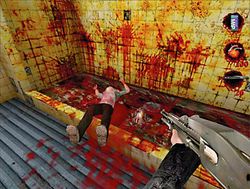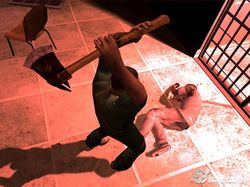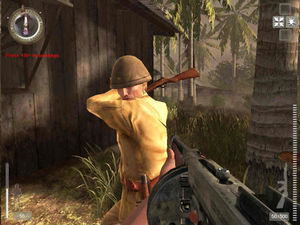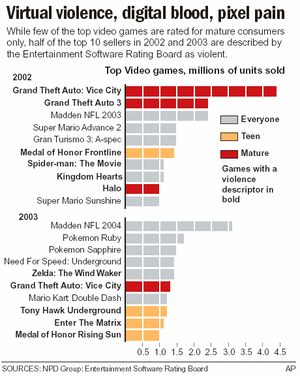Video Game Violence
Tutorial 30 Group 2
Contents
Group Members
Eric Tobiasz
Natalie Ng
Justin Berger
Rebecca Jones
Introduction
Video games were first introduced in 1947 and have been extremely popular since the 1970s. However, there has been an issue regarding the violence of video games and whether or not it affects the gamers to apply the same behaviour and attitude towards the real world. Lately, there has been a lot more games released dealing with violent themes such as shooting, killing and other violent activities. More or less, not only do adults enjoy this type of gaming, but also children who might be attending elementary.
Project Statement
This project focuses on violence in video games and the affects of violence on the individuals who play these games. It looks at both the increase in overall violence and mature themes as well as the the increase in popularity of these video games. This report includes information about the Entertainment Software Rating Board which is the primary organization responsible for applying guides on the recommended age groups for each video game title and the overall effectiveness of these ratings.
Video Game Violence
Animation is becoming more and more realistic; this is allowing games to be more graphic and life-like than ever before. Even though most of the inappropriate games are rated Mature, doesn’t mean that only those aged 17 and over are playing them. Some of the most popular games are ones that involve murdering, and crime. Images with large amounts of blood and gore, hate, crime, destruction, alcohol and drug use, and even sexuality are all very popular now a days. Even most of the games for younger children involve some sort of theatrical violence and mischief. One of the main causes of concern is not only that these images exist in the games, but the player themselves are often the ones doing the killing and destruction. Games like Grand Theft Auto are based on pointless violence. In the online mode, gamers get together to cause as much destruction and killing as possible to win. These actions are of concern because repetitive events lead to learning, and children continue to learn about violence at earlier and earlier ages.[1][2]
Popularity
Violence in games has become very popular with people of all ages. There have been many different types of studies relating to the violence of video games. For example, a study tested 47 different types of video games and resulted in 40 of the 47 games relating in violent content. However, studies also show that the more violent the game is, the more popular and entertaining gamers find it. Of course, not only do guys play these games, but also girls. When it comes to video game violence, the most popular games deal with fantasy and human violence where girls prefer fantasy and boys prefer human violence. Nowadays, the most popular games dealing with violence would probably have to be Grand Theft Auto, Halo and Mass Effect.The popularity level of violent games has also become an addiction to many gamers. Some people get so into the game that they might not have dinner, might not take showers, skip class and even not get any sleep! For example, a fifteen year old boy ran away from home because his parents took away his gaming console. The boy went missing and unfortunately, police found a dead body which was believed to be the boy.
Game Rating System
ESRB System
The ESRB game rating is usually found on the bottom left hand corner on the front of the game case. This is for quick reference to what the game is rated and what age group it is acceptable for. On the back, the lower right hand corner will usually have a section containing content descriptors. This shows what kind of offensive content is in the game while also explaining why it is rated what it is.
Entertainment Software Rating Board
[3]ESRB Content Descriptors
| Alcohol Reference | - Reference to and/or images of alcoholic beverages |
| Animated Blood | - Discolored and/or unrealistic depictions of blood |
| Blood | - Depictions of blood |
| Blood and Gore | - Depictions of blood or the mutilation of body parts |
| Cartoon Violence | - Violent actions involving cartoon-like situations and characters. May include violence where a character is unharmed after the action has been inflicted |
| Comic Mischief | - Depictions or dialogue involving slapstick or suggestive humor |
| Crude Humor | - Depictions or dialogue involving vulgar antics, including “bathroom” humor |
| Drug Reference | - Reference to and/or images of illegal drugs |
| Fantasy Violence | - Violent actions of a fantasy nature, involving human or non-human characters in situations easily distinguishable from real life |
| Intense Violence | - Graphic and realistic-looking depictions of physical conflict. May involve extreme and/or realistic blood, gore, weapons and depictions of human injury and death |
| Language | - Mild to moderate use of profanity |
| Lyrics | - Mild references to profanity, sexuality, violence, alcohol or drug use in music |
| Mature Humor | - Depictions or dialogue involving "adult" humor, including sexual references |
| Nudity | - Graphic or prolonged depictions of nudity |
| Partial Nudity | - Brief and/or mild depictions of nudity |
| Real Gambling | - Player can gamble, including betting or wagering real cash or currency |
| Sexual Content | - Non-explicit depictions of sexual behavior, possibly including partial nudity |
| Sexual Themes | - references to sex or sexuality |
| Sexual Violence | - Depictions of rape or other violent sexual acts |
| Simulated Gambling | - Player can gamble without betting or wagering real cash or currency |
| Strong Language | - Explicit and/or frequent use of profanity |
| Strong Lyrics | - Explicit and/or frequent references to profanity, sex, violence, alcohol or drug use in music |
| Strong Sexual Content | - Explicit and/or frequent depictions of sexual behavior, possibly including nudity |
| Suggestive Themes | - Mild provocative references or materials |
| Tobacco Reference | - Reference to and/or images of tobacco products |
| Use of Drugs | - The consumption or use of illegal drugs |
| Use of Alcohol | - The consumption of alcoholic beverages |
| Use of Tabacco | - The consumption of tobacco products |
| Violence | - Scenes involving aggressive conflict. May contain bloodless dismemberment |
| Violent References | - References to violent acts |
Effectiveness of Game Rankings
These ratings are mainly just a guideline for parents and their children. There is no real enforcement on who is playing the game. Rated Mature games are becoming more available to youth. Some stores will sell a mature rated game to almost anyone, while other stores will strictly enforce the age requirement of 17 and will ask the person buying it for ID and proof of age. If a person under the age of 17 possesses a mature rated game, there is nothing officials can do if they are caught with it. No one but the parents can take these games away. Also, some parents will buy any game that their child asks for without considering or looking at the rating of it. However, some parents are the opposite of this and swear by the rankings, saying they will never let their child play a game that is apparently not acceptable for their age group. 90 % of teenagers say that their parents pay no attention to the ratings of the games they are playing. [4]This shows how little most parents are controlling what kind of content their child is exposed to. It seems that he ERSB rating system is more effective for the younger age groups when it is the parent that buys the games, but at the gamer gets older, the ratings do little to control what they play. [5][6]
Research
Statistics
According to research, boys play video games on average thirteen hours a week and five hours a week on average for girls [7](Anderson, Gentile, & Buckley, under review; Gentile, Lynch, Linder, & Walsh, 2004). Research done by Children Now in 2001 showed that the majority of the games had violence; and about half of injuries caused in these games would result in serious injuries or death in the “real world”.
-Children's use of video games has become widespread. A recent survey of families with school-age children found that 74% of families with school-age children own video game equipment, and school-age children play video games an average of 53 minutes per day.
-While most parents (88%) report regularly supervising their children's use of television, only about half report regularly supervising their children's use of video games (48%).
-A 2001 review of the 70 top-selling video games found 89% contained some kind of violence.
-Almost half of all games (49%) contained serious violence, while 40% contained comic violence.[8]
Experiments
In order to gather more information we are going to look at an experiment done by Cooper and Mackie in 1986. In this experiment both researchers used 84 children (boys and girls) from ages 10-11. They assigned them to play or observe a violent video game in this case it was Missile Command, a non violent video game (Pac-Man) or pen-and-paper game for eight minutes. After that they were observed during a free play period where they could choose different type of toys aggressive (dart gun), an active toy (basketball) a game that required skill (pinball) and finally a quiet game (building logs). Finally children were given the opportunity to punish or reward another participant by suggesting how much punishment a child should receive for their actions. (Cooper, J., & Mackie, D., 1986)
According to this experiment the children that played or observed the violent video game played with the violent object for a longer period of time. This was particularly on girls. They also noted that the boys that played with the violent game were not affected by the videogame. They did find that the children that observed or played the violent game were more active afterwards. Finally the punishment suggested by the children that played Missile Command was not different than from those who played Pac-Man. Finally some of the problems that most experiments present are the following:
- 1. None of these experiments look at the long term effect that videogames have on human beings they only focus on the short term (immediate) effect that they have on humans.
- 2. The subjects that on which the experiments are based on do not have voluntary play. They are told when to play and when to stop.
- 3. Subjects do not have free will when carrying out these experiments. They are told what to play for how long, told where to sit, the type of lighting, etc. When people play videogames they are usually in the comfort of their home and have everything they want. E.g. Lighting, comfort, volume, etc.
Real-life Occurrences
According to the information offered, it is said that video games lead to real life violence, whether that is true or isn’t true is what we intend to figure out here. What better way to look at a real life example where there was some violence after people played video games. The example we are going to talk about is the Columbine High School massacre. This massacre occurred April 20th 1999 in the small town of Columbine in Jefferson county Colorado. The facts are the following, Eric Harris and Dylan Klebold killed 12 and a teacher of that high school as well as that they wounded 23 others and after they committed suicide. Such massacre shocked the whole nation of the United States of America as well as the world. How video games relate to this massacre is because of the following. It is said that both characters that participated in the massacre played violent video games such as Doom and Wolfenstein 3 D both very violent video games. Harris created the Harris levels in Doom which was a sequel of stages were he could continue playing on, and he also created the “Tier” which according to one officer it resembles the layout of the Columbine High School. (Shepard, 1999) According to this we could say that video games do lead to violence, but we can’t only rely on this information to determine if video game violence leads to real life violence.
Conclusion
It is clear that violence in video games has been increasing. This increase and some recent high profile acts of violence associated with video games have increased the concern and awareness among parents of the affects of violence in video games on their children. Based on a large number of studies done on video game violence, it is difficult to come to a concrete conclusion on whether video games really do cause real life violence. However it does appear that violent video games are associated with increased aggressive behavior and thoughts. In spite of this video games do not force people to commit crimes, but they do desensitize society with the portal of realistic violence in video games.
References
- 1. http://electronics.howstuffworks.com/video-game-violence.htm/printable
- 2. http://www.peace.ca/videoviolence2.htm
- 3. http://www.parentstv.org/ptc/parentsguide/videogameratings2.html
- 4. http://www.tentonhammer.com/node/26747
- 5. http://abcnews.go.com/GMA/story?id=1354811
- 6. http://www.psychologymatters.org/videogames.html
- 7. http://www.apa.org/science/psa/sb-anderson.html
- 8. http://www.gamespot.com/features/6090892/index.html
- 9. http://acolumbinesite.com/about.html
- 10. http://www.msnbc.msn.com/id/23204875/











